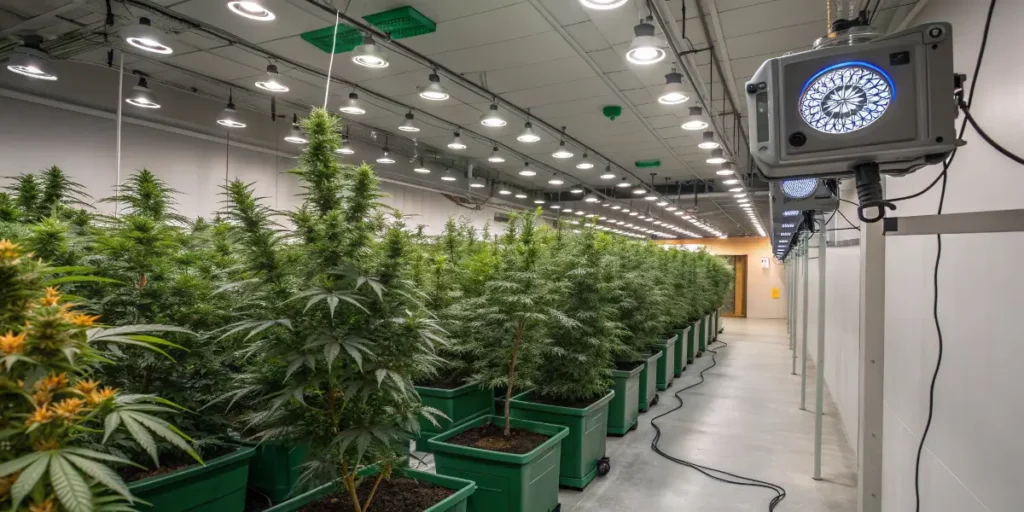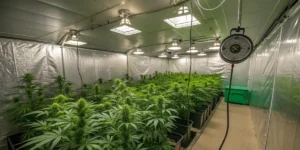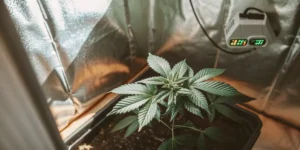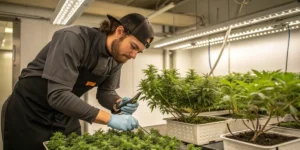Tangie, a unique and vibrant sativa-dominant hybrid, is beloved by cannabis enthusiasts for its distinct tangerine aroma and uplifting effects. Growing Tangie can be a rewarding experience for both beginners and seasoned cultivators. This guide provides a step-by-step approach to cultivating Tangie, emphasizing its specific needs and ideal conditions for successful growth. By following these steps, you can ensure a bountiful harvest of high-quality buds.
To start, choose high-quality Tangie seeds or clones from a reputable source. Tangie is known for its resilience but still requires careful consideration of its growing environment. For best results, consider growing indoors where you can maintain consistent conditions, although outdoor cultivation in a Mediterranean climate can also be successful. Ensure your growing medium, whether soil or hydroponics, is well-aerated and has the ability to retain moisture since these factors are crucial for Tangie’s rapid growth and development.
Pay careful attention to temperature and humidity levels. Tangie flourishes in temperatures between 70-85°F (21-29°C) with humidity levels ranging from 40-50% during the vegetative stage and 30-40% during the flowering stage. Proper ventilation and air circulation are essential to prevent mold and mildew, especially given Tangie’s dense buds. Invest in fans and exhaust systems to maintain these conditions and promote robust plant health.
Lighting is another crucial factor. Tangie responds well to high-intensity grow lights that mimic the sun’s natural spectrum. During the vegetative stage, ensure your Tangie plants receive 18-24 hours of light per day to promote vigorous growth. Switch to a 12/12 light cycle as you enter the flowering stage, typically around week 8-9, to trigger bud development. The entire cultivation period lasts approximately 9-10 weeks from seed to harvest.
Nutrient management is key to maximizing Tangie’s potent yield. Use a balanced nutrient solution during the vegetative stage, followed by phosphorus and potassium-rich fertilizers as the plant enters the flowering phase. Be wary of nutrient burn, and regularly check the pH of your growing medium to ensure it stays within the optimal range of 6.0-7.0. Regularly monitoring and adjusting nutrients will ensure your plant remains healthy throughout its lifecycle.
Pruning and topping are recommended techniques for Tangie. By removing excess foliage and topping central stems, you’ll encourage lateral growth and improve light penetration, resulting in denser, higher-quality buds. Always use sterilized tools to avoid introducing pathogens and pests to your Tangie plants. Additionally, regular inspections are important to detect any pests early, such as spider mites or aphids, which can significantly damage your plants if left unchecked.
Finally, the harvest period is a crucial phase, and recognizing the right time to harvest is vital. Wait for the buds to develop a frosty appearance with amber trichomes, which is an indicator of maturity and maximum potency. After harvesting the buds, proper drying and curing are essential to preserve Tangie’s unique terpenes and flavors. Dry your buds in a dark, ventilated area before curing them in airtight containers for a few weeks, checking them regularly to prevent mold development.
By adhering to these steps, you’ll be well on your way to growing a successful crop of Tangie. With its vibrant aroma and uplifting effects, your patience and attention to detail will undoubtedly be rewarded with a bountiful and high-quality harvest.
tangie Strain Overview: Traits, Effects & Genetics
The Tangie strain is a remarkable and vibrant sativa-dominant hybrid, celebrated for its exquisite citrus aroma and impressive genetic lineage. Its origins can be traced back to the crossbreeding of California Orange and a Skunk hybrid, which creates a powerful combination of sweet and zesty flavors reminiscent of ripe tangerines. These traits have made Tangie a favorite amongst cannabis connoisseurs who seek a flavorful yet potent experience. The strain, often lauded for its uplifting effects, retains a balanced profile and offers a moderate THC content typically ranging between 19% to 22%, making it suitable for both recreational and medicinal users.
In terms of effects, Tangie is renowned for its energizing and uplifting properties. Consumers often report an initial cerebral rush that inspires creativity, focus, and a sense of euphoria, making it an ideal choice for daytime use. As the high progresses, users may experience a soothing relaxation throughout the body, though it generally doesn’t lead to sedation. These effects make Tangie an excellent option for those battling stress, anxiety, and depression, as it can provide relief and promote a positive mindset. It also has a reputation for enhancing social gatherings and sparking engaging conversations thanks to its mood-boosting qualities.
The genetics of Tangie are fascinating and contribute significantly to its distinct characteristics. The crossbreed of California Orange and a Skunk hybrid not only lends its vibrant citrus flavors, but also brings robustness in terms of plant growth and yield. Tangie plants tend to grow tall with a characteristic sativa-like structure, requiring ample space and warmth to flourish. The flowering phase typically lasts about 9 to 10 weeks, which is accompanied by the rewarding scent of citrus filling the growing area. The blending of these genetics results in a strain that is not only resilient and potent but also a joy to cultivate, with a high yield of dense, resinous buds often with striking orange hairs, a sight as unique as its aroma and taste.
Optimal Environment to Grow Tangie Successfully
Tangie, a popular and award-winning cannabis strain, is renowned for its aromatic citrus fragrance and potent effects. To cultivate Tangie successfully, creating an optimal growing environment is crucial. Tangie’s roots can be traced back to California, thriving best in climates mimicking the warm, sunny conditions found there. Ensuring suitable temperature, humidity, and lighting conditions is vital for the healthy growth and prolific flowering of this strain.
Temperature plays a significant role in the growth of Tangie. During the vegetative phase, maintain temperatures between 70°F and 85°F (21°C to 29°C) to promote strong and vigorous growth. Once the plant transitions to the flowering stage, temperatures should be slightly reduced, ideally ranging from 65°F to 80°F (18°C to 27°C). Precise temperature control helps in enhancing the unique terpene profile, which is highly coveted by growers and users alike.
Humidity levels are equally important in cultivating Tangie successfully. During the early vegetative stage, cannabis plants thrive in higher humidity, around 60-70%. However, as the plant matures, and particularly during the flowering stage, the humidity should be gradually reduced to about 40-50% to prevent mold and mildew. Proper ventilation and airflow are paramount to maintaining these optimal humidity levels, ensuring robust plant health.
Lighting is another critical factor in the growth of Tangie. As a photoperiod strain, Tangie relies on lighting cycles to trigger different growth stages. During the vegetative phase, providing 18-24 hours of light encourages maximum vegetative growth. Transition to a 12-hour light/dark cycle to promote flowering as the plant matures. Full-spectrum LED lights are recommended for their efficiency and ability to mimic natural sunlight.
To sum up, by carefully regulating temperature, humidity, and lighting, growers can replicate the ideal environment for Tangie, promoting healthy growth and maximizing yield. These factors, combined with proper soil or hydroponic mediums and nutrient management, can help cultivate a premium-quality Tangie harvest, fully exhibiting its delightful citrus aroma and powerful effects.
Grow Room Setup
The Tangie strain, known for its fruity citrus aroma and uplifting effects, requires a carefully controlled environment to thrive indoors. Setting up a dedicated grow room is essential for maximizing the potential of your Tangie plants. To start, choose a space that will maintain a stable environment, ideally a room where temperature and humidity can be easily controlled. Ensure that the room is sealed to prevent pests and external light, which could disrupt the plant’s growth cycle.
Lighting is a crucial aspect of growing Tangie indoors. This strain responds well to high-intensity lighting, which replicates the sun’s natural rays. LED grow lights are recommended due to their energy efficiency and ability to maintain consistent light levels. Aim for a light cycle of 18 hours on and 6 hours off during the vegetative stage, and adjust to 12 hours on and 12 hours off for flowering. Make sure to hang the lights at an appropriate distance from the plants to prevent burning the leaves while ensuring adequate light penetration.
The climate within the grow room must be precisely controlled to mimic the ideal outdoor conditions for Tangie. This strain prefers a temperature range of 70-85°F (21-29°C) during the day, with a slight drop at night. Humidity levels should be kept at 40-50% during the vegetative stage, decreasing to around 30-40% in the flowering phase to prevent mold and mildew. Equipping your grow room with a reliable thermometer and hygrometer is essential for monitoring these conditions.
Another important aspect is air circulation and ventilation, which is vital for the healthy growth of Tangie plants. Install oscillating fans to ensure even air distribution around the plants and prevent hot spots. Additionally, use ventilation systems with carbon filters to remove odors and ensure a fresh air supply. This not only provides CO2 necessary for photosynthesis but also helps to strengthen the plant’s stems by mimicking the natural movement caused by outdoor winds.
Lastly, consider the growing medium and containers. Tangie plants typically prosper in high-quality potting soil amended with perlite or coco coir for better aeration and drainage. Use containers with adequate drainage holes to prevent water accumulation, choosing sizes that accommodate the plants’ growth throughout the cycle. Regularly check the pH levels of the soil and water to ensure they remain within the optimal range of 6.0-6.5 for Tangie plants.
Indoor Growing Tips for Tangie
Tangie is a popular cannabis strain known for its citrus aroma and uplifting effects, making it a favorite among indoor growers. To successfully cultivate Tangie indoors, it’s essential to manage the environment carefully to mimic the conditions this plant thrives in. Tangie flourishes with controlled temperature settings between 70-85°F (21-29°C) during the day and slightly cooler temperatures at night. Consistency in temperature is crucial, as fluctuations can stress the plant, potentially affecting growth and yield.
Lighting is another crucial factor in the successful indoor cultivation of Tangie. This strain benefits significantly from strong and consistent lighting, ideally utilizing LED grow lights due to their full-spectrum capabilities and efficiency. Adequate light intensity will encourage robust vegetative growth and high yields during flowering. Provide Tangie with at least 18-20 hours of light during the vegetative stage to simulate longer summer days, then switch to 12 hours of light during the flowering stage to stimulate budding.
Maintaining optimal humidity levels is just as important when growing Tangie indoors. During the vegetative phase, keep the humidity between 40-60% to prevent mold and mildew, as Tangie’s dense foliage can trap moisture. As the plant moves into the flowering stage, gradually reduce the humidity to 40-50% to avert bud rot while enhancing resin production. Implementing proper ventilation will also help regulate humidity and strengthen plants by simulating natural breezes.
Finally, successful Tangie cultivation relies on proper nutrition. This strain responds well to a balanced nutrient regimen with a focus on phosphorus and potassium during the flowering stage. Use quality soil rich in organic matter to bolster growth and consider supplementing with calcium and magnesium to prevent deficiencies. Regularly monitor pH levels of the growing medium, maintaining it between 6.0 and 6.5, to ensure optimal nutrient uptake. With these tips, indoor Tangie growers can expect vibrant, aromatic crops bursting with tangy flavor.
Outdoor Growing Tips for Tangie
Tangie is a popular cannabis strain known for its vibrant citrus aroma and uplifting effects, making it a favorite among outdoor growers. Cultivating Tangie outdoors can be highly rewarding due to its sativa-dominant genetics which allow it to thrive under natural sunlight. One critical factor to consider when growing Tangie outdoors is the climate. Ideally, Tangie prefers a warm and sunny environment, mirroring the typical Mediterranean climate. Therefore, it is crucial to plant your Tangie seeds or clones after the last frost to protect them from unexpected cold snaps.
In terms of soil, Tangie thrives in well-draining, nutrient-rich substrates. Consider using organic soil enriched with compost to provide an excellent nutrient base for your plants. Adding amendments like perlite or vermiculite can enhance drainage and aeration, crucial for healthy root development. Regularly check the pH of the soil, aiming for a pH level between 6.0 and 7.0, to ensure optimal nutrient uptake. Furthermore, practicing crop rotation by alternating the cannabis planting location each year can help maintain soil fertility and structure.
Tangie is known for its resilience against pests and diseases; however, it is not entirely immune. Employing organic pest management strategies such as introducing beneficial insects like ladybugs and praying mantises can help control pests naturally. Additionally, regularly inspecting your plants for signs of fungi or pest infestations, especially during humid conditions, is crucial to prevent outbreaks. Trim and prune the lower leaves and branches to improve airflow and reduce the likelihood of mold and mildew setting in, particularly during the flowering stage.
Watering practices are also essential for successfully cultivating Tangie outdoors. It is important to strike a balance between under and over-watering, as both can negatively affect plant health. During the summer months, it may be necessary to water more frequently due to high temperatures and increased evaporation. A drip irrigation system can offer consistent moisture without over-saturating the soil. Always water in the early morning or late afternoon to lessen water loss due to evaporation and prevent scorching the plants under direct sunlight.
Finally, as Tangie matures, it can benefit from a boost in phosphorus and potassium to encourage flowering and resin production. Transitioning to a bloom-specific nutrient regimen as your plants start to flower enhances the development of the distinctive, terpene-rich buds that Tangie is famous for. Keep a close eye on the trichomes to determine the optimal harvest time, ensuring you capture the full spectrum of effects and flavors this exceptional strain has to offer.
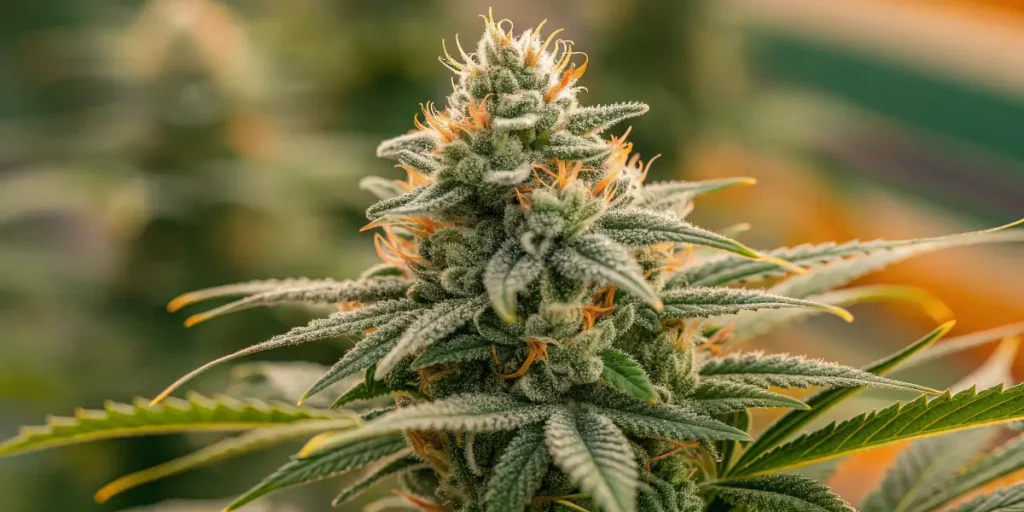
How to Germinate & Propagate Tangie
Germinating and propagating Tangie, a vibrant cannabis strain known for its citrusy aroma and potent effects, can be a fulfilling process for both novice and seasoned cultivators. Tangie responds well to traditional germination techniques, such as the paper towel method, which involves placing seeds between moist paper towels and ensuring a warm environment of about 70-75°F (21-24°C). Regularly check the seeds for moisture levels, ensuring the towels remain damp but not soaked, to prevent mold. Under optimal conditions, Tangie seeds will sprout within several days, signaling their readiness for planting.
Once sprouted, Tangie seeds should be transferred gently to a nutrient-rich growing medium, such as a quality potting soil or a specialized cannabis soil mix. Fill small pots or seedling trays and create small indentations to accommodate the delicate seedlings. Carefully place each germinated seed into its respective spot and cover lightly with soil. This setup should then be exposed to a consistent light source for approximately 18 hours a day, simulating natural spring sunlight and encouraging healthy growth. Ensure proper drainage and soil aeration to facilitate the roots’ development and oxygen intake.
Propagation of Tangie can be achieved successfully through cuttings, enabling growers to replicate desirable genetic traits. Select a healthy mother plant, ideally during the vegetative stage, to take cuttings from. Use sterilized scissors to cut branches below the node, making a clean cut of about four to six inches. Dip the cutting in rooting hormone to promote root development and plant it into a pre-moistened growing medium or a rooting cube. Keep the cuttings in a humid environment, ideally under a dome or plastic cover, to maintain moisture and encourage root growth.
Successful germination and propagation of Tangie lay the foundation for a thriving cannabis grow. Whether starting from seed or propagating from clones, ensuring optimal conditions will yield robust plants. Patience and careful monitoring during these initial stages greatly influence the eventual quality and yield of the Tangie strain, making these steps crucial for any cannabis enthusiast aiming to cultivate this aromatic variety.
Vegetative Stage
The vegetative stage of Tangie, a vibrant sativa-dominant hybrid known for its citrusy aroma and uplifting effects, is crucial for establishing a strong foundation for healthy growth and bountiful yields. During this phase, Tangie plants are focused on developing their root systems, stems, and foliage. It’s essential to provide optimal conditions to encourage vigorous growth and prepare the plants for the forthcoming flowering stage. The vegetative period typically lasts between 4 to 6 weeks, depending on your growing objectives and environmental conditions.
Lighting plays a pivotal role during the vegetative stage. For Tangie, an 18/6 light cycle is ideal, providing 18 hours of light and 6 hours of darkness each day. This schedule mimics natural longer daylight periods of summer, promoting robust growth. Full-spectrum LED lights are recommended as they offer energy efficiency and reduced heat output, preventing light burn and allowing plants to thrive. Maintain your lights at an appropriate distance to avoid scorching your plants while ensuring they receive sufficient illumination for photosynthesis.
Nutrition is another critical aspect of nurturing Tangie plants during the vegetative stage. Utilize a nutrient regimen high in nitrogen to support leaf and stem development. A balanced nutrient mix containing essential minerals such as potassium and phosphorus should also be incorporated to ensure overall plant health. Regularly monitor pH levels in your soil or hydroponic solution, aiming for a pH range of 6.0 to 7.0 for soil or 5.5 to 6.5 for hydroponics. This balance aids nutrient absorption, promoting vigorous growth and disease resistance.
Besides lighting and nutrition, proper watering is vital to the success of your Tangie plants during this phase. Overwatering can lead to root rot, while underwatering can stress the plants, hindering their development. It’s crucial to establish a consistent watering schedule that allows the top inch of soil to dry out between sessions. This practice helps prevent fungal issues and encourages the roots to expand and strengthen, resulting in more resilient plants.
Lastly, implementing training techniques such as topping or low-stress training (LST) during the vegetative stage can significantly enhance the structure and yield potential of Tangie plants. By carefully bending or topping the main stem, growers can encourage a bushier canopy, enhancing light penetration and promoting the development of multiple colas. These strategies lead to a more uniform plant structure, ultimately contributing to a more abundant and quality harvest.
Flowering Tangie: What to Expect
The flowering stage of Tangie, a popular sativa-dominant hybrid, is an exciting and crucial period for growers. Renowned for its citrusy aroma and uplifting effects, Tangie typically takes around 9 to 10 weeks to flower completely. As you enter the flowering phase, expect your plants to stretch significantly in the first few weeks. This growth spurt is a common trait, reflective of its sativa lineage. Ensure your grow space accommodates this increase in height to prevent any issues with light burn or overcrowding, which can hinder flowering.
As the plants continue to flower, you’ll observe the development of thick, vibrant buds which will become increasingly coated in sticky trichomes. These trichomes are responsible for Tangie’s high THC levels and aromatic terpenes, which contribute to its signature orange-tangerine scent. To promote optimal bud development, maintain a consistent lighting schedule and optimal environmental conditions—typically, a temperature range between 68°F to 78°F and a humidity level of around 40-50% is ideal. Regularly check your plants for any signs of nutrient deficiencies or pest infestations, as resolving these quickly during flowering is crucial for a healthy yield.
In the latter stages of flowering, you’ll notice the distinct orange pistils of Tangie beginning to darken and curl inwards, indicating the plant is nearing harvest. At this point, it’s important to monitor the trichomes closely; many growers harvest when a majority of trichomes appear milky with a few turning amber, ensuring a balance between potency and flavor profile. Flushing the plants with pure water in the final weeks can help improve the taste of the final product by removing any excess nutrients. Harvest your Tangie plants with care, and prepare to enjoy an invigorating, citrusy experience.
Fertilizers & Nutrient Schedule
Feeding the Tangie cannabis strain correctly is paramount to achieving its distinctive citrusy aroma and robust growth. Tangie is known for its vibrant terpene profile and vigorous growth patterns, requiring a balanced nutrient schedule to reach its full potential. Start by focusing on a basic N-P-K (Nitrogen, Phosphorus, and Potassium) ratio during the different growth phases. In the vegetative stage, a higher nitrogen concentration (such as a 3-1-2 ratio) is beneficial to promote lush foliage and robust vegetative growth. This essential nutrient will ensure the plant’s leaves can effectively perform photosynthesis, leading to healthier plants.
As Tangie transitions into the flowering stage, it demands a shift in the nutrient lineup, placing more emphasis on phosphorus and potassium (such as a 1-3-3 ratio). Phosphorus supports the development of flowers and potency, while potassium enhances the plant’s overall vigor and resistance to diseases. Providing a well-balanced bloom booster can help maximize the flower production and improve the quality of buds. Regularly assessing pH levels is crucial throughout Tangie’s growth cycle; a neutral pH will allow the roots to absorb the nutrients effectively.
Feeding schedules vary depending on the growth medium used—soil, soilless mixes, or hydroponics. For soil-grown Tangie, apply liquid fertilizers every other watering, allowing the soil to partially dry between sessions. For hydroponic setups, nutrients can be provided more frequently, offering a steady supply of essential elements. As with any cannabis strain, observe your Tangie plants closely and adjust the feeding schedule as needed. Symptoms like yellowing leaves or burnt tips can signal nutrient imbalances or overfeeding, requiring immediate attention to amend the issue. Proper nutrient management ensures a flourishing Tangie harvest infused with its signature tangy fragrance and flavor.
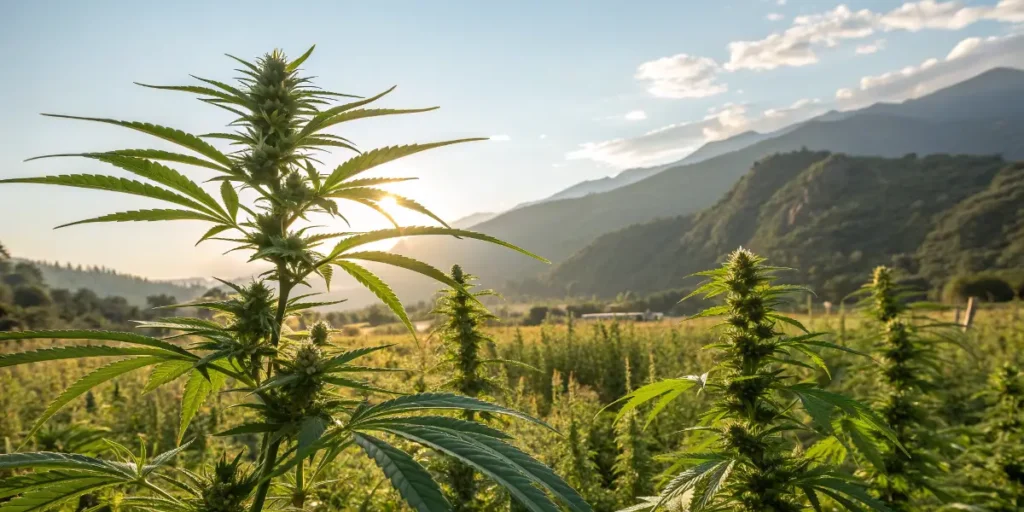
Pest and Disease Prevention for Healthy Cannabis Plants
Preventing pests and diseases is crucial for maintaining robust cannabis plants, especially when growing strains such as Tangie, known for their aromatic and flavorful nugs. One of the key strategies is to ensure that your growing environment is clean and well-maintained. Regularly inspect your plants for any signs of pests or diseases, such as discolored leaves or unusual spots. Keeping a tidy grow space reduces the risk of infestations and helps you identify and address any issues early. Additionally, implementing a consistent cleaning routine for your tools and equipment minimizes the entry of contaminants.
Another essential aspect of pest and disease prevention involves the use of biological controls and natural repellents. Introducing beneficial insects like ladybugs and predatory mites can help control pest populations by naturally feeding on harmful invaders such as aphids and spider mites. Companion planting with herbs like basil and dill can also deter pests while promoting plant health. For Tangie growers, employing neem oil as a natural pesticide can be effective against a broad range of common cannabis pests without harming the plant itself.
Proper watering and ventilation also play a significant role in preventing mold and disease. Overwatering can lead to root rot and create a hospitable environment for fungal infections like powdery mildew. Ensure that your Tangie plants have adequate drainage and are not sitting in stagnant water. Good airflow is also essential. Consider investing in oscillating fans to maintain air movement within your grow area, reducing the likelihood of mold and other moisture-related issues. By combining these strategies, you can establish a healthy, pest-free environment for your cannabis plants.
Harvesting & Drying the Right Way
Harvesting Tangie at the optimal time is crucial to preserving its distinct citrus aroma and ensuring the highest quality yield. The best indication of readiness is to observe the trichomes on the buds. Using a magnifying glass or jeweler’s loupe, look for trichomes that have transitioned from clear to a milky white color, with some turning amber. This change indicates that the cannabinoids are at their peak potency. Additionally, Tangie’s vibrant orange pistils should have mostly turned a deep amber hue, signaling maturity. Make sure to harvest during the day when the plant’s energy levels are balanced.
Once you have determined that your Tangie plants are ready for harvest, carefully cut the branches to minimize damage. It’s advisable to wear gloves during this process to protect the resinous buds from any contamination. Trim away the large fan leaves as they hold little value for consumption, but leave the smaller sugar leaves, which can be rich in trichomes. Be delicate during this process to retain as many trichomes as possible, as they are responsible for Tangie’s potency and flavor profile.
Proper drying is essential to preserve Tangie’s characteristic flavor and prevent mold. Hang the branches upside down in a controlled environment with a temperature between 60-70°F (15-21°C) and a humidity level of 50-60%. Good air circulation is critical, so make use of fans to keep the air moving without directly hitting the buds. Typically, the drying process can take 7-10 days, where the stems should snap rather than bend, indicating the buds are ready for the next step.
After the initial drying phase, the Tangie buds should undergo a curing process to enhance flavor and potency. Place the dried buds in airtight glass jars, filling them up to 75% to allow for adequate air movement. Store these jars in a cool, dark place, opening them daily for the first two weeks to release any built-up moisture and replace it with fresh air, a process known as burping. This curing phase can last from two weeks to a month, gradually bringing out and preserving the pungent citrus and skunky notes that Tangie is loved for.
Tangie Strain Type: Indica, Sativa or Hybrid?
The Tangie strain, revered for its spectacular citrus aroma and uplifting effects, is largely considered a Sativa-dominant hybrid. It is a modern reimagining of the famed Tangerine Dream strains from the 1990s, with a profile that highlights its predominantly Sativa characteristics, balanced by a negligible Indica influence. Cultivators and connoisseurs appreciate its refreshing tangerine scent which it owes to its unique terpene profile, providing an enticing sensory experience, often described as invigorating and perfect for creative endeavors.
Typically, the Tangie strain exhibits a genetic composition of around 70% Sativa and 30% Indica, which contributes to its ability to produce energizing and mood-enhancing effects. This Sativa dominance makes it an excellent choice for daytime use, as it promotes clear-headedness, creativity, and motivation without the heavy sedation often associated with Indica strains. This balance, while tilted toward Sativa, allows Tangie to deliver versatile effects making it a favorite among users seeking a strain that fosters both mental stimulation and mild physical relaxation.
In terms of cultivation, the Sativa genes within Tangie result in tall plants with lengthy flowering times, much like many traditional Sativa strains. Growers should be prepared for a growth cycle that can extend from 9 to 10 weeks. While the plants require patience due to their longer flowering period, the reward is substantial. The yield tends to be generous, with the buds emanating an irresistible citrusy aroma. As a Sativa-leaning hybrid, Tangie thrives both indoors and outdoors, but it requires careful attention in order to flourish and produce quality buds that showcase its euphoric qualities.
Ultimately, while it is a hybrid with subtle Indica influences, Tangie shines through predominantly as a Sativa strain, making it perfect for those who seek a lively, creative high. Its ability to elevate mood, spur creativity, and enhance focus makes it one of the top choices for those in search of a Sativa-dominant hybrid that delivers on all fronts. From its alluring fragrance to its impressive effects, Tangie offers a unique profile that stands out in the increasingly crowded field of cannabis hybrids, appealing to both growers and users alike.
Key Benefits for Cultivators
Tangie, a popular sativa-dominant cannabis strain, is renowned for its citrusy aroma and delicious flavor profile, reminiscent of tangerines and other citrus fruits. For cultivators, the decision to grow Tangie can be rewarding not only for its unique sensory appeal but also for its relatively simple growing requirements. This strain has gained popularity due to its robust growth patterns and impressive yields. Its sativa dominance means that it thrives well both indoors and outdoors, offering flexibility and adaptability to various growing environments. This characteristic can be particularly beneficial for cultivators who may be limited by space or location.
Furthermore, Tangie’s relatively short flowering period of about 9-10 weeks makes it an attractive choice for growers seeking moderate turnaround times. This allows for multiple cultivation cycles within a single year, maximizing production and revenue potential when operational and seasonal conditions are favorable. Moreover, Tangie often delivers impressive yields of dense, resin-rich buds, further enhancing its appeal for commercial and personal cultivators alike. The average height of Tangie plants can be managed with proper training techniques, such as topping and LST, to optimize light exposure and air circulation, promoting healthier growth and improved yields.
Another key benefit of cultivating Tangie is its resilience against common pests and mold issues. This resistance can greatly reduce the need for heavy pesticide use, contributing to a more organic growing process and potentially lowering operational costs. For growers looking for a strain that offers both quality and sustainability, Tangie is an excellent choice. Additionally, its uplifting and energetic effects have made it a popular choice among consumers, ensuring a robust market demand that can be advantageous for both new and experienced cultivators. Overall, Tangie presents a harmonious balance of ease of growth, high yield potential, and marketability, making it a compelling option for cannabis enthusiasts and professionals.
Potential Challenges When Growing Tangie
Tangie is celebrated for its vibrant citrus aroma and uplifting effects, making it a sought-after strain among cannabis enthusiasts. However, growers may face several challenges during its cultivation. The first significant challenge is its heightened susceptibility to molds and mildews. Tangie’s dense buds and high resin production can create an environment conducive to mold growth. To mitigate this risk, maintaining proper ventilation and humidity levels in the grow space is crucial. Ensuring adequate airflow will help prevent mold spores from settling on the plant, thereby safeguarding its health and quality.
Another challenge that cultivators may encounter is nutrient sensitivity. Tangie plants can be particularly picky when it comes to their nutritional intake, requiring a balanced feeding schedule to ensure healthy growth. An overdose or deficiency of essential nutrients can lead to nutrient burn or deficiencies, which manifest as discolored or malformed leaves. Regularly monitoring the plant’s nutrient uptake and adjusting the feeding regimen as needed can help maintain Tangie’s vigor. Employing organic nutrients and maintaining pH levels in the optimal range can further enhance plant health and yield.
Tangie is also known for its stretchy growth patterns, which can be challenging for growers with limited vertical space. This strain tends to grow tall and lanky, often requiring training techniques to manage its height. Methods such as topping, low-stress training (LST), or the Screen of Green (ScrOG) can be employed to control its upward growth and encourage a more bushy, manageable stature. These practices not only help with space management but also promote light penetration to the lower branches, leading to greater bud development.
Finally, Tangie’s relatively long flowering period can pose a challenge for growers seeking quick harvests. This strain typically takes around 9-10 weeks to flower, requiring patience and careful monitoring. During this period, it is essential to provide consistent care, ensuring that environmental conditions such as light, temperature, and humidity remain stable. Keeping a close eye on trichome development will be key to determining the optimal harvest window and ensuring the desired terpene profile and potency.
Is Tangie Worth Buying? Here’s What You Need to Know
Tangie is a sativa-dominant hybrid strain renowned for its refreshing citrus aroma, reminiscent of tangerines, which is a result of its tangy lineage. This strain, a homage to the popular Tangerine Dream, offers more than just its pleasant scent. It’s celebrated for its uplifting effects, making it a favorite among users seeking a burst of energy and creativity. If you’re considering adding Tangie to your collection, knowing its unique qualities and potential benefits is crucial.
Growing Tangie can be a rewarding endeavor for both novice and experienced cultivators. The strain is prized for its relatively easy cultivation process and its robust growth, which typically results in high yields. The plants favor a sunny climate akin to their Californian heritage but can thrive indoors under the right conditions. Its resilience to mold and pests makes it a viable option for growers looking to expand their repertoire without taking on overly complex challenges.
Besides the cultivation benefits, Tangie provides a significant experiential value to consumers. Its effects are predominantly cerebral, lending itself to enhance creativity, focus, and social interactions. The euphoric and energetic buzz makes it an excellent choice for daytime use. This strain is ideal for users needing an inspiration boost or wanting to elevate their mood without the heavy sedative effects common in many other strains.
However, like any cannabis strain, Tangie has its considerations. The potent sativa effects might not be suitable for everyone, especially those with a low tolerance for THC or individuals prone to anxiety, as its energetic qualities could potentially exacerbate such conditions. Therefore, potential buyers should weigh these factors and consider personal preferences and tolerance levels before purchasing.
To sum up, Tangie is indeed worth buying for those seeking a vibrant and uplifting cannabis experience, coupled with the rewarding experience of high-yield cultivation. Its delightful citrus aroma, coupled with the energizing effects and relative ease of growth, make it a distinguished addition to any cannabis enthusiast’s collection. Whether you’re growing your batch or purchasing ready-to-use options, knowing Tangie’s characteristics and benefits will ensure a satisfying choice.
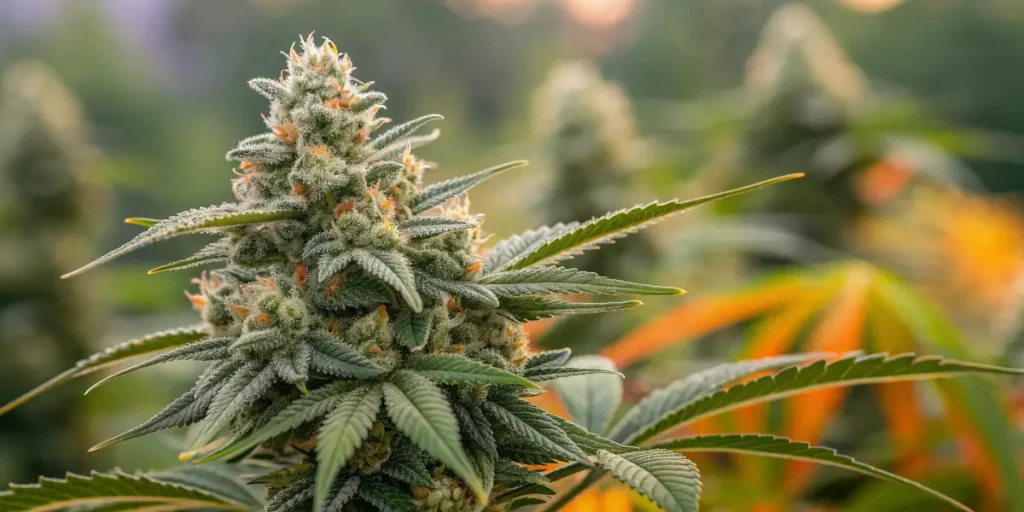
FAQs about Tangie
What is Tangie?
Tangie is a popular hybrid strain of cannabis known for its uplifting effects and distinct citrus flavor, reminiscent of tangerines. It’s a sativa-dominant strain that is a cross between California Orange and Skunk #1. Tangie has gained popularity for its potential to boost creativity and energy, making it a favorite among both recreational and medicinal users looking to enhance their mood.
What are the effects of consuming Tangie?
Consuming Tangie typically results in energizing and euphoric effects, combined with a heightened sense of creativity and focus. Users often report feeling uplifted and happy, which can be beneficial for those combating stress, depression, or fatigue. Due to its cerebral effects, it is often recommended for daytime use. As with any cannabis strain, effects can vary based on individual tolerance and consumption method.
What does Tangie smell and taste like?
Tangie is famous for its strong citrus aroma and flavor. When consumed, users frequently describe its taste as being citrusy with a sweet undertone, akin to eating a freshly peeled tangerine. The scent of Tangie is similarly dominant, carrying a sweet, yet spicy citrus odor that can easily permeate its surroundings. This distinctive profile is largely due to its terpene content, especially limonene.
Are there any medical benefits associated with Tangie?
Medically, Tangie is often used for its potential to alleviate symptoms of stress, anxiety, and depression due to its uplifting nature. It’s also popular as an aid for those who struggle with fatigue, as it can provide a burst of energy and focus. Some users find it helpful in managing mild pain or headaches, though it is not typically known for its analgesic properties compared to other strains with higher CBD content.
How does Tangie compare to other citrus-flavored cannabis strains?
Tangie stands out among citrus-flavored cannabis strains due to its particularly potent tangerine taste and aroma. While other strains might offer citrus notes, the intensity and sweetness of Tangie’s flavor and fragrance are unmatched. Compared to strains like Lemon Skunk or Orange Crush, which also carry citrus profiles, Tangie is often preferred for its ability to clearly impart a fruity tangerine experience. Additionally, its mood-enhancing effects are frequently cited as being more pronounced.

